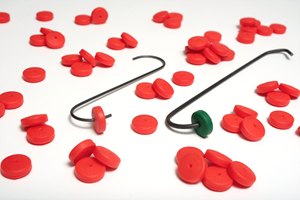Is E-Coat Right for Me?
What are the steps in deciding if electrocoat is my best coating alternative?
Share
Q. What are the steps in deciding if electrocoat is my best coating alternative? J.C.
A. If you are an Electrocoater, you probably have people asking you part of this question occasionally. If you are a potential e-coater or are considering having your parts e-coated, this outline can probably help you make that decision.
This question is best answered by answering four other questions. Lets look at those questions in outline format:
1. What is the purpose of the coating? (To determine the correct resin system)
1.1. Corrosion protection
1.1.1. Epoxy if not exposed to direct sunlight.
1.1.2. Epoxy (black is cheapest and most available) if used as a primer for liquid or powder topcoat. Two-coat electrocoat is also available.
1.1.3. High-grade substrate and pretreatment with acrylic coating if exposed to direct sunlight.
1.2. Color retention and selection
1.2.1. Significant volume (square feet of product surface to be coated) is required per color (see question/answer above).
1.2.2. Consider e-coat for the largest volume color and use it as a primer for other colors?
2. What is the volume, size (minimum and maximum dimensions) and weight (pounds and maximum part thickness) of parts? (To determine type and size of equipment for material handling, pretreatment, coating, and curing).
2.1. Maximum part size (length x width x depth) will determine package size.
2.2. Minimum part size may determine labor, tooling and material handling because electrocoat can handle significant part density versus liquid or powder (if the part gets wet, it gets coated).
2.3. Volume of parts (per color—see 1.2.1 above) will help determine throughput (line speed on monorail systems, or carriers/hr. on square transfer systems) of the system.
2.4. If part size and volume varies significantly, labor, tooling and/or material handling will be affected since loading and unloading the line will vary. Power-and-free conveyor systems can help resolve this problem but is quite expensive.
2.5. Maximum part weight and material thickness will probably determine the curing cycle (time and temperature) and the need for forced cooling. If the part weight and material thickness varies significantly, over-curing the lighter weight parts can affect color and gloss (as will line stoppages).
3. Will the system be installed in a new building or an existing one? (To determine material handling system)
3.1. Building size (length, width and height) and design (column spacing, structural steel, and possible pits) will affect the coating system design.
3.2. If the system is to be installed in an existing building, the same information is needed but usually limits the equipment suppliers in design, material handling and installation.
3.3. How will parts be delivered to and removed from the electrocoat system? This can again affect labor and material handling options.
4. Are there local, city or state environmental restrictions? (To determine pretreatment, waste treatment, and curing equipment)
4.1. If water discharge restrictions are severe, the type of pretreatment (zinc vs. iron phosphate; chrome vs. non-chrome or no sealer) or waste treatment (type and size) will be affected
4.2. The type of e-coat material may affect water discharge also as small quantities of heavy metals are present in some e-coats
4.3. While e-coat materials have very low (or zero) VOC content compared to liquid coatings, some VOCs may need to be addressed
4.4. Air discharge restriction may affect curing equipment (products of curing varies by resin system)
Answering these four questions, and having the information for the equipment, pretreatment and e-coat material suppliers, will speed up the quoting process and determine options available. I also strongly recommend a group meeting of the potential suppliers. If you are not sure that e-coat is the best alternative, getting samples coated at a custom coater can help with decisions on appearance, quality, etc. The Electrocoat Association (www.electrocoat.org) can be an excellent source of potential suppliers or Custom Coaters.
Related Content
CFS Unveils New Hook Locks Parts Racking Solution
New product from Custom Fabricating & Supplies (CFS) prevents part loss during coating processes.
Read MoreSustainability, Electrification and Mobility
Industry events like ECOAT are good indicators of the trends that are top of mind for those in manufacturing.
Read MoreCoatings Plant Evolves with Market Trends
Expanding its focus from exclusively serving the RV industry, one of this company’s stand-alone coatings plant has successfully extended its services to additional markets.
Read MoreTTX’s Automated Conveyor Carrier System Offers Wireless, Flexible Operation
ACC system designed for reliable, consistent point-to-point movement of everything from small to heavy parts.
Read MoreRead Next
Delivering Increased Benefits to Greenhouse Films
Baystar's Borstar technology is helping customers deliver better, more reliable production methods to greenhouse agriculture.
Read MoreEducation Bringing Cleaning to Machining
Debuting new speakers and cleaning technology content during this half-day workshop co-located with IMTS 2024.
Read MoreMasking Solutions for Medical Applications
According to Custom Fabricating and Supplies, a cleanroom is ideal for converting, die cutting, laminating, slitting, packaging and assembly of medical-grade products.
Read More















.jpg;maxWidth=300;quality=90)








